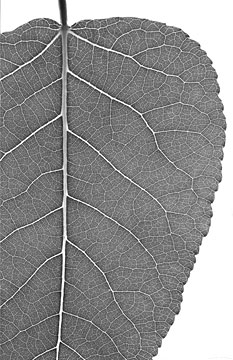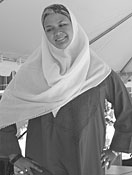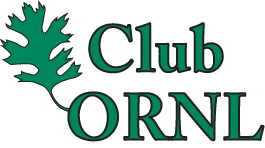 |
Number 82, October 2006 |
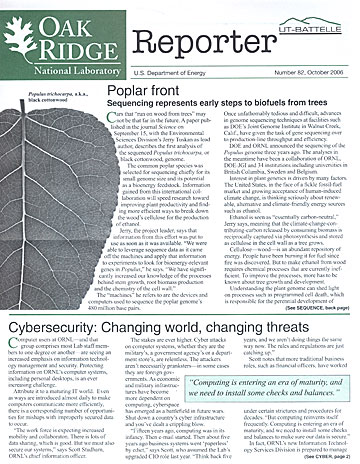 |
|
| Lab Notes | |
|
|
|
|
|
|
|
|
|
| Society names ORELA nuclear historic landmark | |
| Letters | |
| Want an active lifestyle? Join Friends of ORNL | |
| Stairclimbing safety tips | |
| Busy fall for Club O | |
| New Staff Members | |
| ORNL People |
 Poplar front
Poplar front
Sequencing represents early steps to biofuels from trees
|
|
| Populus trichocarpa, a.k.a., black cottonwood |
Cars that “run on wood from trees” may not be that far in the future. A paper published in the journal Science on September 15, with the Environmental Sciences Division’s Jerry Tuskan as lead author, describes the first analysis of the sequenced Populus trichocarpa, or black cottonwood, genome.
The common poplar species was selected for sequencing chiefly for its small genome size and its potential as a bioenergy feedstock.
Information gained from this international collaboration will speed research toward improving plant productivity and finding more efficient ways to break down the wood’s cellulose for the production of ethanol.
Jerry, the project leader, says that information from this effort was put to use as soon as it was available. “We were able to leverage sequence data as it came off the machines and apply that information to experiments to look for bioenergy-relevant genes in Populus,” he says. “We have significantly increased our knowledge of the processes behind stem growth, root biomass production and the chemistry of the cell wall.”
The “machines” he refers to are the devices and computers used to sequence the poplar genome’s 480 million base pairs. Once unfathomably tedious and difficult, advances in genome sequencing techniques at facilities such as DOE’s Joint Genome Institute in Walnut Creek, Calif., have given the task of gene sequencing over to production-line throughput and efficiency.
DOE and ORNL announced the sequencing of the Populus genome three years ago. The analyses in the meantime have been a collaboration of ORNL, DOE-JGI and 34 institutions including universities in British Columbia, Sweden and Belgium.
Interest in plant genetics is driven by many factors. The United States, in the face of a fickle fossil-fuel market and growing acceptance of human-induced climate change, is thinking seriously about renewable, alternative and climate-friendly energy sources such as ethanol.
Ethanol is seen as “essentially carbon-neutral,” Jerry says, meaning that the climate-change-contributing-carbon released by consuming biomass is reciprocally captured via photosynthesis and stored as cellulose in the cell wall as a tree grows.
Cellulose—wood—is an abundant repository of energy. People have been burning it for fuel since fire was discovered. But to make ethanol from wood requires chemical processes that are currently inefficient. To improve the processes, more has to be known about tree growth and development.
Understanding the plant genome can shed light on processes such as programmed cell death, which is responsible for the perennial development of the plant—how wood is formed and why the autumn leaves turn colors and fall off. Knowledge of how the cell wall is formed will lead to strategies to deconstruct it again, which is critical to making fuel, Jerry says.
Researchers are also interested in other genomes that could help unlock efficient ways to break down wood. Termites, for instance, are terrific at wood deconstruction. Finding out how the microbial community within the insect’s gut processes wood could one day unleash an industry that would dwarf the pest-control business.
“History will look at the poplar genome project as a major event in forest biology, a major step forward.” |
|---|
It’s not inconsequential that the forest industries are major economic players in Canada, Sweden and the United States. There is a definite economic factor in advancing the understanding of forest biology.
“Three years ago we began discussing how to move forest biology forward. Long-lived, large trees can’t propagate in greenhouses. Forest trees are difficult to work with. So we proposed to DOE that we could accelerate the development of bioenergy crops by sequencing the black cottonwood,” Jerry says.
What they learn will speed up the process of domestication—breeding the best attributes into a plant. Humans have domesticated plants and animals for eons, a process that has given us dairy cattle, gourmet popcorn and seedless watermelons.
“By having the gene library at our fingertips we accelerate the domestication process in Populus. In five years we’ll be able to produce poplars with new properties. In 10 years we’ll have plantations of energy crops. In 15 years we may have fully domesticated poplar trees,” he says.
“History will look at this as a major event in forest biology, a major step forward,” says Sam Foster of the U.S. Forest Service. “The sequencing info is very valuable, enabling basic research and practical uses. The value of this information can be applied immediately to standard tree breeding, which we have done for 100 years but never had the sequencing information to make great strides forward.”
“Although the notion of groves of trees with ethanol spigots at their bases is overly optimistic, the poplar genome work lays the groundwork for a day when ethanol will be a main player in the energy market and a major source of fuel,” Jerry says. “Scientists have much to learn to get to that point, but the genome is the window they need to peer into the future.”—B.C ![]()
 Cybersecurity: Changing world, changing threats
Cybersecurity: Changing world, changing threats
Computer users at ORNL—and that group comprises most Lab staff members to one degree or another—are seeing an increased emphasis on information technology management and security. Protecting information on ORNL’s computer systems, including personal desktops, is an ever increasing challenge.
Attribute it to a maturing IT world. Even as ways are introduced almost daily to make computers communicate more efficiently, there is a corresponding number of opportunities for mishaps with improperly secured data to occur.
“The work force is expecting increased mobility and collaboraton. There is lots of data sharing, which is good. But we must also secure our systems,” says Scott Studham, ORNL’s chief information officer.
“Computing is entering an era of maturity, and we need to install some checks and balances.” |
|---|
The stakes are ever higher. Cyber attacks on computer systems, whether they are the military’s, a government agency’s or a department store’s, are relentless. The attackers aren’t necessarily pranksters—in some cases they are foreign governments. As economic and military infrastructures have become more dependent on computing, cyberspace has emerged as a battlefield in future wars. Shut down a country’s cyber infrastructure and you’ve dealt a crippling blow.
“Fifteen years ago, computing was in its infancy. Then e-mail started. Then about five years ago business systems went ‘paperless’ by edict,” says Scott, who assumed the Lab’s upgraded CIO role last year. “Think back five years, and we aren’t doing things the same way now. The rules and regulations are just catching up.”
Scott notes that more traditional business roles, such as financial officers, have worked under certain strictures and procedures for decades. “But computing reinvents itself frequently. Computing is entering an era of maturity, and we need to install some checks and balances to make sure our data is secure.”
In fact, ORNL’s new Information Technology Services Division is prepared to manage our computers for us with tools such as Systems Management Server, which automatically downloads vital software patches to Windows users. Most users are perfectly willing to leave it to the experts. Others, a minority, are quite willing—and able— to manage their own security.
During the next year, however, in a series of moves mandated by DOE and the federal government overall, ORNL must enhance security for all Lab systems, including office desktop computers. Life will change a little bit for some users.
Hackers used to make a lot of noise. Now they keep quiet. |
|---|
For example, virtual private network, or VPN, users are beginning to receive small devices that generate a one-time password. Network administrators have worn these fobs on their badge lanyards for years. To log onto the ORNL network from off site, the users will combine the one-time password, which is good for maybe a minute, with a PIN number to gain access.
“Hackers steal passwords. It’s easy,” Scott says without revealing just how easy. “The one-time passwords prevent this.”
To further strengthen this perimeter of security, ORNL Computer & Network Security has also set a goal to manage all Lab computer systems, which means bringing some users into the fold for the first time. Chief among the newly managed are Mac users, who have been required to install an Apple Remote Desktop utility and authenticate to the ORNL domain, a move that has not gone down well with some.
Times appear to require the measures, however. Where hackers once were predominantly pranksters, or what Scott calls “script kiddies,” now they are foreign governments who realize how much economies and militaries now rely on the cyberworld, and organized criminals, who can make a pile breaking into systems and selling time on those they control.
“The script kiddies shared secrets and made a lot of noise. It was easy to detect them,” he says. “You could keep them out with a virtual mote around the castle.”
But hackers have become much harder to detect. For example, someone came up with a scheme to pay a penny for each time a Web advertisement received a hit. Nefarious programmers began writing software that hijacks a computer, causing it to send numerous hits to ads. For a hacker who controls several hundred machines, the pennies add up. They are making money and staying mum about it.
More ominously, offshore hackers, many likely government-sponsored, have been mining for economic information or even military weaknesses. The first Persian Gulf War, in which coalition forces neutralized Iraq’s communication infrastructure, is seen as a watershed cyber warfare event. Just as the Nazis bombed England’s nascent radar sites, future warriors will mount crippling cyber campaigns against their enemies’ communications systems. Experts believe the constant hacks they see amount to probing for weaknesses.
Closer to home is the nightmare of a cybercrook getting hold of a trove of social security and credit card numbers. It’s happened, and it generates embarrassing headlines and fear in consumers.
Scott, a former Linux programmer, says he appreciates the benefits of a diverse computing community. He has resisted moves to homogenize the Lab computing scene, which would save money and be simpler to secure, but would come at the expense of an open scientific research environment.
Besides, in the future perimeter security—the cyber moat—probably loses relevance.
“Twenty years from now workstations will be cheap, small and abundant. It will be impossible to manage all these castles and huts. But what is important is not if the computer is compromised, but whether the data on it is secure. By then, maybe in five years, we’ll know how to protect each individual document or email.”
In the meantime, however, the Lab’s computer security organization will be stocking the computational castle’s moat with cyber-alligators to keep out the invaders.—B.C. ![]()
 New organizations
include Neutron
Sciences Directorate
New organizations
include Neutron
Sciences Directorate
The new fiscal year has brought organizational changes to ORNL, including a new directorate and two new divisions.
The Spallation Neutron Source and High Flux Isotope Reactor have been combined into a new Neutron Science Directorate, led by Associate Laboratory Director Thom Mason. The new directorate is “charged with delivering safe and productive scientific facilities for the study of structure and dynamics of materials,” says Lab Director Jeff Wadsworth.
The SNS and HFIR will continue as separate facilities; the new directorate will foster scientific integration between the two facilities, Jeff says. Kelly Beierschmitt continues as HFIR executive director and director of Nuclear Operations.
The Neutron Sciences Directorate’s four divisions are the Research Accelerator Division, led by Stuart Henderson; the Research Reactors Division, led by Ron Crone; The Neutron Facilities Development Division, led by John Haines; and the Neutron Scattering Science Division, led by Ian Anderson.
Biological and Environmental Sciences Associate Lab Director Reinhold Mann announced the creation of a new division, the Biosciences Division, which has been created with many components of the former Life Sciences Division. Martin Keller, who recently joined ORNL as deputy director of the Environmental Sciences Division, will direct the new division.
The Environmental Sciences Division has a new Integrated Assessment group that brings together programs in biomonitoring, economics, energy analysis, environmental analysis and remediation, risk assessment, toxicology and society-technology interactions studies.
The Information Technology Services Division, which brings together staff members from across the Laboratory who provide IT services, began operation October 1 under the Computing and Computational Sciences Directorate. The organization, directed by Becky Verastegui, replaces the former Networking and Computing Services Division.
The ITSD leaders include Ron Parr in the Software Applications group, Bob Beane in the User Support Services group, Suzanne Willoughby in the Infrastructure Systems and Software Support group and Don Williams in the Network, Telephony and Video Services group. Mike Turpin is the operations manager for the new division. ![]()
 |
 Riding in Class A
Riding in Class A
ORNL has a brand-new ambulance, delivered in September. You can see it at the fire hall; it has some of the latest and most up-to-date accoutrements, including a stretcher with a motorized lift that makes an ambulance ride less stressful for both the patient and the responders.
The best new thing about the Lab’s ambulance service, however, isn’t the ambulance itself, but who is riding in it. ORNL’s ambulance service is now certified by the state as a Class A service, meaning that the paramedics on board are trained and certified to administer advanced life support or special critical care on virtually all ambulance runs within the ORNL service area, at all times of day.
Which means that if something happens to you, you’ll be in good hands when the first responders arrive.
|
|
| ORNL paramedic Bill Longworth (left) shows the Lab’s new ambulance to Jeff Smith, Mike Masters (behind Jeff), David Baity, Carol Scott, Dr. James Phillips, Donnie Bentley and Herb Debban. |
The presence of paramedics on the Lab ambulances has been credited with saving several lives, including a contract employee injured in a fall and an employee who suffered a massive heart attack. ORNL’s paramedics are also first responders for traffic accidents on the reservation, including the sometimes calamitous State Highway 95.
The certification, which was presented by Steve Hamby of the Tennessee Department of Health’s Emergency Medical Services Division, was made possible through an agreement between the Lab and the Atomic Trades and Labor Council, which represents the firefighters and paramedics.
“The ATLC has been a good partner,” says Deputy Director for Operations Jeff Smith. International Association of Firefighters Local I-2 chief steward Donnie Bentley noted the success of the Lab and union representatives in working out an arrangement so that the ambulances could be staffed with advanced life-support-trained paramedics around the clock, calling it a “win-win.”
“The people who come out ahead of everybody is the population of the Lab,” Donnie says.
 Safety: F&O sees results
Safety: F&O sees results
Safety usually comes to the forefront when the news is bad. Statistics since 2002, however, show that ORNL is making astounding progress in working safely, particularly in the Facilities and Operations Directorate.
Because F&O includes most crafts who do hands-on, physical work, that directorate has historically recorded the highest accident rates. But now they may be setting the bar for safety improvement.
For example, in fiscal year 2002 F&O logged 82 recordable injuries. FY 2006’s number was 31. And that’s down from 34 in FY 2005.
“Days away restricted” injuries plummeted from 46 in 2004 to 16 in 2005 to a mere five in 2006.
“Lost workday away” cases, which typically are the more severe injuries, dropped from 28 in 2002 to just three last year, and a decline from 11 in 2005.
“It’s the fourth year in a row that we’ve been ‘best ever’ in our safety statistics,” says F&O Director Herb Debban.
Herb attributes the improvements to several things. “We’ve been aggressively working on safety improvement. People are being more aware of hazards and are implementing their responsibility to work safely,” he says. “[Lab Director] Jeff Wadsworth keeps safety in the forefront in his communications.”
More specifically, Herb credits the STOP Observation program instituted in 2003. Under that DuPont-developed program, line management observes work in the field, and if they see a hazardous practice or situation, they stop the job and explain the hazard. Safe work practices are reinforced.
Herb says there are typically 1,000 STOP observations conducted in a month within F&O. The program has been so effective here that Herb has been training other Battelle-run labs in the plan. All Lab F&O staff are trained in STOP techniques.
The safety improvements represent significant cost savings for the Lab, but, much more importantly, it means not as many employees are getting hurt.
|
|
| Stacy Hutchens was one of a number of staff members who donned cultural costumes for the United Way’s annual International Festival, held September 20 on Main Street. |
 ORNL’s reality show: The EE Lab
ORNL’s reality show: The EE Lab
“Takes a lickin’ and keeps on tickin’” is an old advertising mantra, but how do you know if it really will? If you want to see if your system or instrument will stand up to the elements, put it through its paces in Engineering S&T Division’s Environmental Effects Laboratory.
The laboratory, located in the east campus’s Engineering Technology Facility as part of ESTD’s Analysis, Characterization and Technology Support program, is a suite of instruments and mechanisms that can simulate just about any insult the world can throw at a piece of equipment.
“We look at real-world situations and mimic them,” says team leader Peter Chiaro, who hosted an open house on September 21.
Those “situations” include temperature, humidity, air pressure, magnetic fields, electromagnetic interference, ionizing radiation, voltage variation, vibration, shock and even dust.
The EE Lab has tested commercial equipment, including more than 200 models of radiation detection instruments.
Peter and his staff, which includes Carl Dukes, Kathy Johnson, Larry Phillips, Ayman Shourbaji and Nathan Wood, can help assure researchers or companies that their equipment will work in the field when things get tough. Check their Website at public.ornl.gov/estd/ACTS/.
—Reported by Bill Cabage |
 Society names ORELA nuclear historic landmark
Society names ORELA nuclear historic landmark
Provided data for reactor design, astrophysics, criticality safety
| by CAROLYN KRAUSE |
In recent years ORNL’s older accelerator-based neutron source has churned out nuclear data in the shadows of its newly born cousin on Chestnut Ridge, the Spallation Neutron Source. But now the 37-year-old Oak Ridge Electron Linear Accelerator is enjoying its own special time in the limelight. In November the American Nuclear Society will recognize ORELA as a Nuclear Historic Landmark.
ANS will formally recognize ORELA November 14 during the society’s 2006 Winter Meeting in Albuquerque, N.M. A plaque commemorating this recognition will be provided for display at ORELA.
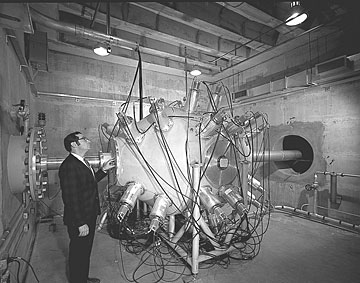 |
Former ORNL researcher Ernie Silver at ORELA’s scintillator tank. ORELA was built primarily to support the Atomic Energy Commission’s fast breeder reactor program but has provided data for a wealth of varied research projects. |
Unlike the SNS, which accelerates protons to generate pulsed neutrons, ORELA bombards a tantalum target with electrons, producing 1,000 neutron pulses per second in the medium energy range, ideal for nuclear reactor design and studies of the formation of elements in exploding stars.
The electron accelerator helps researchers measure the probability that neutrons of a particular energy (determined by time of flight over a known distance) will be captured by target nuclei of an element or will be scattered or will cause the nuclei to fission. When a nucleus captures a neutron, a gamma ray is emitted to an ORELA detector.
“We are quite pleased by the recognition the ANS designation brings to the many years of neutron capture and reaction work carried out at ORELA, starting in August 1969,” says Glenn Young, director of ORNL’s Physics Division, which operates ORELA. “This work produced results with impacts on our basic understanding of neutron-induced reactions, the theory of nuclear reactions, the basic structure of nuclei, the design of advanced nuclear reactors and the reaction cycles that occur in stellar environments to produce many chemical elements, notably those heavier than iron.”
ORELA was constructed during the nuclear power industry’s boom years in the late 1960s. The accelerator and laboratory equipped with neutron flight tubes, detectors and computers for data acquisition and analysis were designed and built to provide accurate, high-resolution neutron cross section measurements in support of the Atomic Energy Commission’s liquid-metal fast breeder reactor program. The program was canceled in the 1980s, but ORELA thrived into the 1990s with as many as 15 principal investigators and considerable engineering and computing support.
Funding for ORELA has declined, but a few people manage to operate the facility five to eight weeks a year.
Fred Maienschein, a co-director of ORELA with Jack Harvey as well as director of the Neutron Physics Division when ORELA opened, says, “The linear accelerator was specifically optimized for producing nuclear data, and it became the world’s leading facility for this purpose.”
ORELA’s linear accelerator became the world’s leading facility for producing nuclear data. |
|---|
ORELA was the source of at least half of the neutron cross-section data sent to the National Nuclear Data Center that Harvey started at Brookhaven National Laboratory. Some of these data are guiding the design of reactors with improved efficiency.
The ORNL landmark also hosted many experiments in fundamental physics. For example, in 1990 Harvey and electronics engineer Nat Hill helped Austrian physicists Jorg Schmiedmayer and Peter Riehs measure the force holding the neutron together. The measurement of the tiny distance separating the neutron’s positive and negative charges shed light on the strong force binding quarks, the neutron’s basic constituents.
Bob Peelle, who led an ORELA research program, recalls “the many visiting scientists from all over the world who brought interesting ideas and questions and who made essential contributions.”
“Most of the neutron data used in nuclear astrophysics came from ORELA,” says Paul Koehler of the Physics Division, who receives funding from the Department of Energy’s Office of Nuclear Physics. “We continue making neutron capture measurements at ORELA today, albeit with much higher accuracy as required by the latest stellar models and observational data.”
Computational astrophysicists using ORELA data model the nuclear processes by which isotopes of elements heavier than iron are synthesized in red giant stars and supernovae. Such models predict relative abundances of isotopes produced in stars, enhancing scientific understanding of the life and death of stars and the formation of our solar system.
ORELA is also used for criticality safety cross-section measurements performed by Klaus Guber, a researcher in the Nuclear Data Group in ORNL’s Nuclear Science and Technology Division. He receives funding from DOE’s National Nuclear Security Administration to perform nuclear data measurements to support the NNSA Nuclear Criticality Safety Program.
“As an example, ORELA’s neutron data are useful for calculations on fissile material handling, such as the safe spacing between storage drums of fissile material to prevent criticality accidents, which might release radiation,” explains Mike Dunn, leader of NSTD’s Nuclear Data Group. Mike was instrumental in winning the ANS recognition of ORELA, giving ORNL, with the addition of the SNS, two acclaimed accelerator-based neutron sources in 2006. ![]()
 ORNL welcomes new Wigners
ORNL welcomes new Wigners
 |
|
| Sovacool | Shuford |
Two new Eugene P. Wigner Fellows have come to the Lab under the two-year fellowships named for the Nobel laureate and ORNL’s first scientific director.
Deputy Director for Science & Technology Jim Roberto welcomed the new Wigners and recognized current and former Wigner fellows at the annual Wigner fellows reception on September 19. He noted that over the 31 years of the fellowship program, which was begun by the late former Lab Director Herman Postma, about two-thirds of Wigner fellows have remained at ORNL and 33 of the 79 Wigner fellows over the course of the program are still on the ORNL staff.
Former Wigner fellows typically excel as Lab researchers. Two recent examples are Steve Zinkle, who heads the Materials S&T Division, and recent Presidential Early Career Award winner Dan Bardayan of the Physics Division.
The new arrivals’ research interests range from energy policy to nanoscience.
Benjamin Sovacool is working in the Engineering S&T Division’s Cooling, Heating and Power group with Bob DeVault and Jeff Muhs, where he is pursuing interestes in energy efficiency and renewable energy practices and policy and laboratory research methods. Ben, a Canton, Ohio, native who received his doctorate in S&T studies this year from Virginia Tech, will have his first book, Energy and American Society: Thirteen Myths—coauthored and edited by former Lab researcher Marilyn Brown—published in early 2007.
Kevin Shuford, from Wilmington, N.C., received his doctorate from the University of Florida in 2003. Kevin joined the Laser Spectroscopy and Chemical Microtechnology group in the Chemical Sciences Division in August, working with Bob Shaw. With 14 publications including a book chapter, Kevin plans to study nanoparticle coupling mechanisms, energy transfer in complex architectures, nanoparticle-based sensing devices and theoretical method development.
ORNL expects to add another Wigner fellow later this fall. Participation in the fellowship program is expected to grow from a current seven to 10.—B.C. ![]()
 UT-Battelle supports Oak Ridge rowing facility upgrade
UT-Battelle supports Oak Ridge rowing facility upgrade
UT-Battelle has donated $60,000 to the Oak Ridge Rowing Association to build new regatta launch docks at the Melton Hill Lake rowing site and help make Oak Ridge the nation’s premier location for competitive rowing.
The gift brings UT-Battelle’s total contribution to the rowing association to $123,000 since 2000. The latest donation will supplement the $100,000 in capital improvements to the rowing site approved by the Oak Ridge city council.
“UT-Battelle’s corporate outreach philosophy is to identify a small number of large legacy investments rather than a large number of small ones,” says ORNL Director Jeff Wadsworth.
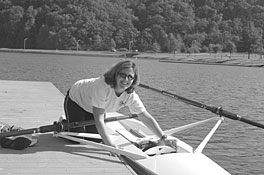 |
Nicole Porter, ORNL General Counsel and a member of the Oak Ridge Rowing Association, can attest to the ideal rowing conditions on Melton Hill Lake. |
“Our strategy is simple. We have the water. If we add a first-class rowing facility, Oak Ridge will attract an increasing number of rowing competitions that will generate significant revenues for the city,” Jeff says.
Previous gifts from UT-Battelle include the construction of a finish-line tower needed for national rowing competitions.
ORRA President Mary Jane Sill says, “Support from the city and UT-Battelle, along with the lake’s ideal rowing conditions and natural beauty, combine to make Oak Ridge the South’s premier site for competitions, regattas and other national rowing events.”
The Oak Ridge Rowing Association, formed in 1979, hosts more regattas than any other club in the nation. The 2005 U.S. Rowing Club of the Year, the association was the site of the Masters National Championship Regatta in 1984, 1988 and 2004, as well as a number of national collegiate and high school competitions. Oak Ridge will be host to the NCAA National Championships in 2007. The events attract thousands of visitors and bring thousands of dollars to area hotels and restaurants.
“The Rowing Association is an excellent example of how the corporate community can work with the city on a project that will bring returns for years to come,” Jeff says. “If this is a priority for the city, together we can make Oak Ridge one of America’s top locations for competitive rowing.”—Mike Bradley
![]()
 Letters
Letters
More ‘recycling’
I read with interest the article on the SMAC Facility (“SMAC lives on in Alabama”), in the August edition of the ORNL Reporter. It reminded me of a similar story about “recycling” scientific equipment, as we transferred our 10-meter Small Angle X-ray Scattering instrument from the (then) Condensed Matter Sciences Division to New Mexico State University, Las Cruces, in 2003. Over the previous two decades, it was used to characterize a wide variety of materials (> 105 samples) in research undertaken in support of DOE programs and also in collaboration with external users from universities, industry, and other government laboratories.
Dr. J. S. Lin was the local contact for the facility, and literally hundreds of ORNL staff and visitors used it in structural investigations on length scales of 5 -1000D to publish over 20 refereed papers per year, as well as similar numbers of conference presentations, theses, seminars etc. It is now back in operation and anyone interested can contact Professor J. Urquidi (e-mail: jurquidi@nmsu.edu, phone (505) 646-5199), who has indicated that NMSU would welcome previous users to take data on the instrument.
George Wignall
Center for Neutron Scattering
 Want an active lifestyle? Join Friends of ORNL
Want an active lifestyle? Join Friends of ORNL
The Friends of ORNL may be thought of as a retiree organization, but it is open to anyone who has an interest in the Laboratory, its welfare and its programs, regardless of current or former ties to the Lab. It’s also the club to join if you are interested in science.
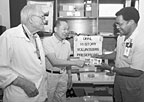 |
(From left) Friends of ORNL Charles Congdon and Bill Yee (with Jim Hall) are ORNL History Room volunteers. |
The Friends have also made their mark in the Oak Ridge community by sponsoring scientifically themed lecture series, helping preserve Lab history and backing a number of educational and community-related activities.
Formed in 1991 as a support organization on behalf of the Laboratory, FORNL numbers about 160 members who are scientists and engineers, as well as individuals from varied backgrounds, who believe they can increase the nation’s technological awareness by providing information to teachers, students and the general public.
FORNL officers are Connor Mathews, president, who is retired from DOE-ORO; Steve Stow, vice-president; Bob Costner, secretary; and Warren Webb, treasurer. Other directors are Ken Cowser, Dean Eyman, Bob Hightower, Steve Hildebrand, Marilyn McLaughlin and Will Minter.
The Friends sponsor the Dick Smyser Community Lecture Series, an annual slate of free lectures on a wide range of topics of interest to the local community, usually held at the American Museum of Science and Energy. The series is supported by contributions from UT-Battelle and BWXT Y-12, with additional support from The Oak Ridger and AMSE.
FORNL members also act as tour guides, or “ambassadors,” for the DOE Facilities Public Bus Tours and other ad hoc tours which may be scheduled during the year. They speak to tour participants from all over the country about past and present-day activities at the three DOE sites, while also sharing information on their personal experiences.
The activities of Friends of ORNL over the years have been quite varied.
